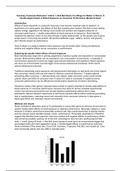Samenvatting
Summary Consumer Behaviour all articles (article 1 to 18)
- Instelling
- Universiteit Van Amsterdam (UvA)
Complete and detailed summary of all articles for the course Consumer Behaviour (Master Business Administration - Consumer Marketing or Digital Marketing). The summary also includes all the important images.
[Meer zien]




